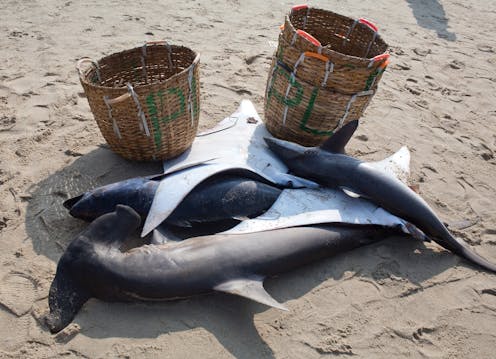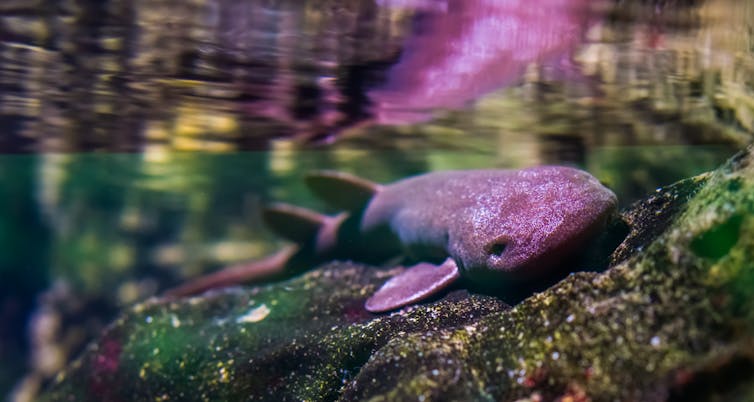
Sharks, along with rays, and their products have been historically consumed and traded by many communities globally over centuries. Between 2012 and 2019, the trade in shark and ray meat was valued at over US$4.1 billion.
Sharks and rays each have complex and distinct chains of supply and distribution, which are harder to unravel, affecting the success of management initiatives. This is concerning for conservation efforts to be successful as sharks and rays are some of the most threatened species today, mostly due to overfishing.
In India, fresh, salted and dried shark meat were traditionally consumed in several coastal communities, especially along the country’s west coast. There, shark meat was a diet staple for the poor. Sharks are also consumed for cultural reasons, as their meat is considered a nourishing food for mothers after childbirth; while ray meat is consumed during festivities.
As a response to the rising global demand for sharks between 1950 and 1980 for shark products such as shark liver oil and shark fin soup, targeted shark fisheries developed in several parts of India to meet this demand. One such place was the Andaman Islands, where I conducted my research between 2018 and 2019.

Consumption preferences
Locals in the Andaman Islands preferred consuming reef fish, due to the taste, tough skin and difficulty in cooking sharks and rays. However, as most of the fish caught in the Andaman Islands are exported, the consequent local shortages of reef fish led to locals consuming what was available.
Another factor in the rise in consumption was the migration of people from parts of mainland India and Southeast Asia to the Andaman Islands who consumed sharks and rays traditionally. Not all shark and ray species were preferred for consumption and trade: smaller sharks were preferred as the texture of their meat was softer.
One such example is from a community in Middle Andaman who started consuming nurse sharks due to their availability and declines of other reef fish. They locally call them “biscuit sharks” due to the texture of the shark when consumed.
There is a common belief in mainland India that milk sharks (Rhizoprionodon acutus) were especially beneficial to pregnant and lactating women. However, all sharks under a metre in length were misidentified as milk sharks.
Our research also found that there were consumption preferences when it came to rays. Those which were uniformly coloured (such as Pateobatis jenkinsii and Pateobatis fai) and had white meat were also preferred over spotted rays (Himantura uarnak) and those with black meat (all eagle rays and devil rays).
Complex trade routes
Local shark and ray consumption on the Andaman Islands is at a much smaller scale than the export of sharks and rays outside the islands. The trade routes for sharks and rays are complex, with each product having its own distinct supply chain.
Shark meat from smaller sharks (less than one metre in length) was sold in domestic markets on the Indian mainland. Other products sold included meat from larger sharks and rays, meat and leather from small sharks (individuals measuring less than one metre in length).
In international markets, demand was for products such as shark and ray meat from larger individuals, ray skin for the leather industry, gill plates from mobula rays for medicines, and shark liver oil for tonics.

Our results also suggested that a targeted stingray fishery is now developing on the islands to supply the high demand for meat on peninsular India. This is profitable due to the perceived high abundance of rays in the islands, the demand, and the lack of policies on stingrays. This is concerning as stingrays are even more threatened than sharks.
Further, the trade affects stakeholders differently. For example, small scale fishers informed us about the declines in shark populations in these areas, which also affects their livelihoods. However, fishers who have the resources to invest in boats and gear that can fish sharks from offshore areas perceive them to be abundant. This also causes conflict between stakeholder groups as those with networks and resources benefit more than others.
Protecting sharks and rays
While there are international regulations such as the Convention on International Trade in Endangered Species of Wild Fauna and Flora in place, our findings make it clear that there is an urgent need to regulate the domestic trade in India.
Additionally, increasing awareness of how consuming sharks and rays endangers them is important. Any regulations and policies should be developed with local communities whose livelihoods may be affected.
Understanding how and why sharks and rays are consumed and traded can inform where and how interventions should be made. Such studies also help us identify species most at risk.
Zoya Tyabji does not work for, consult, own shares in or receive funding from any company or organisation that would benefit from this article, and has disclosed no relevant affiliations beyond their academic appointment.
This article was originally published on The Conversation. Read the original article.







